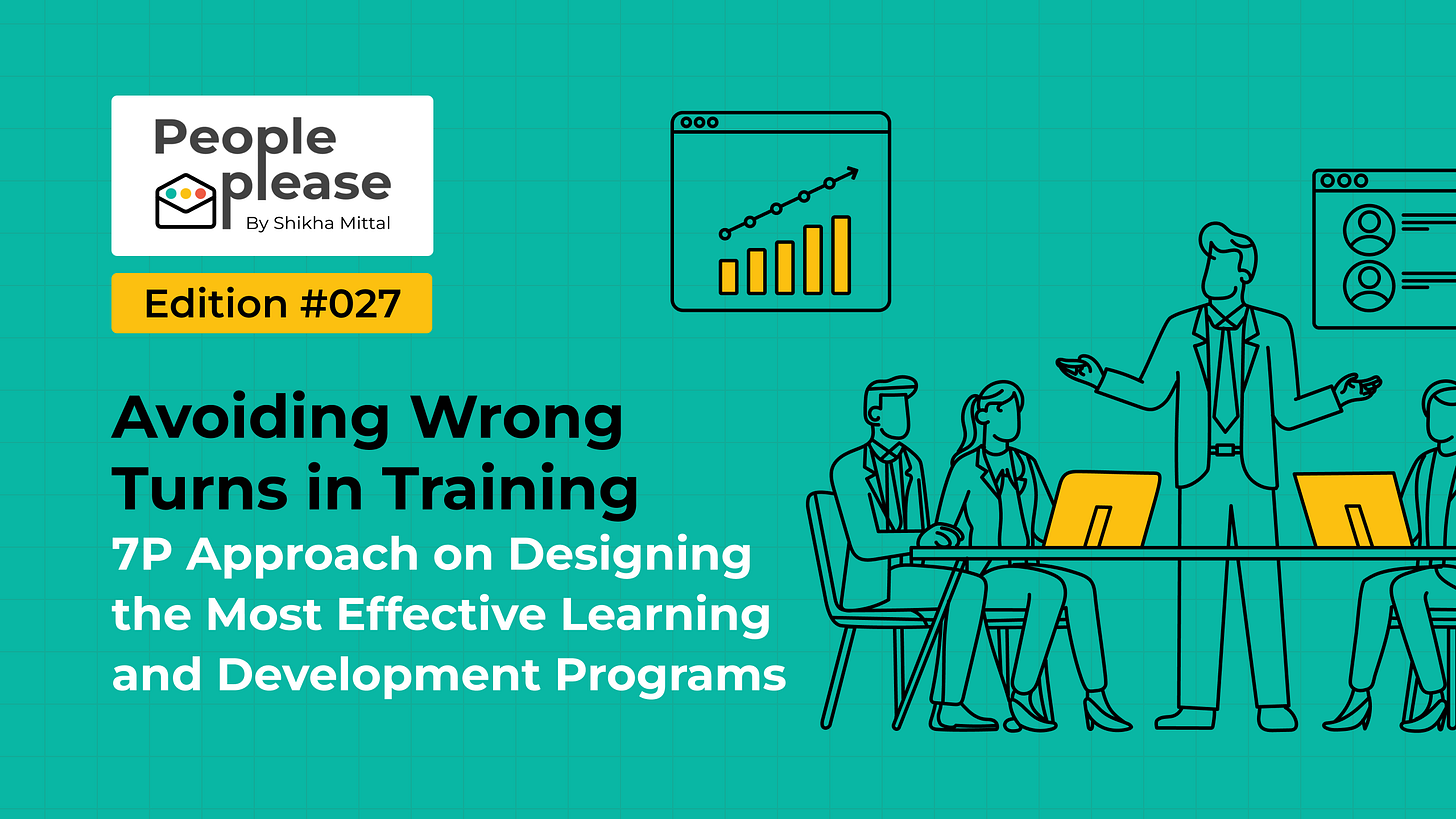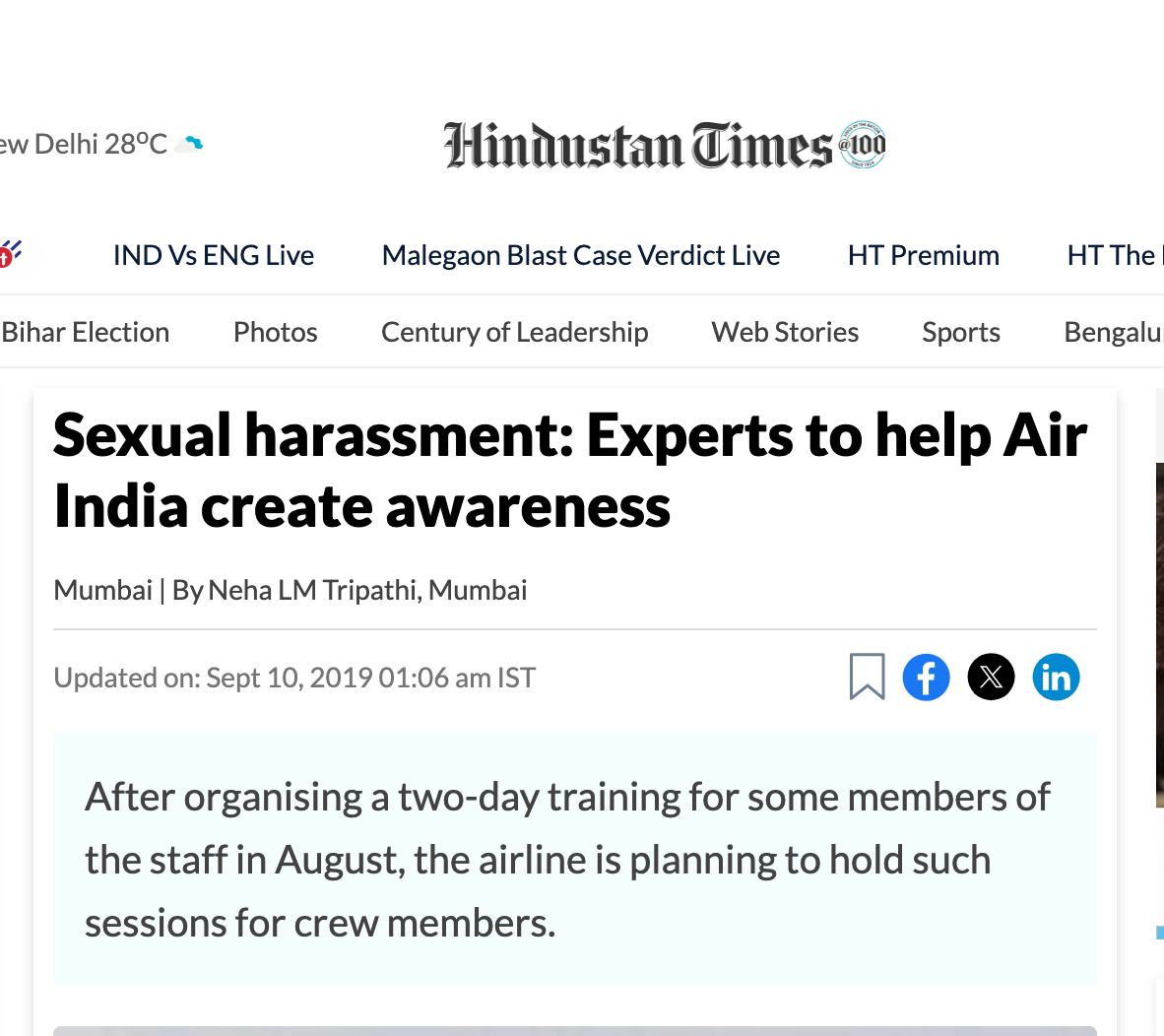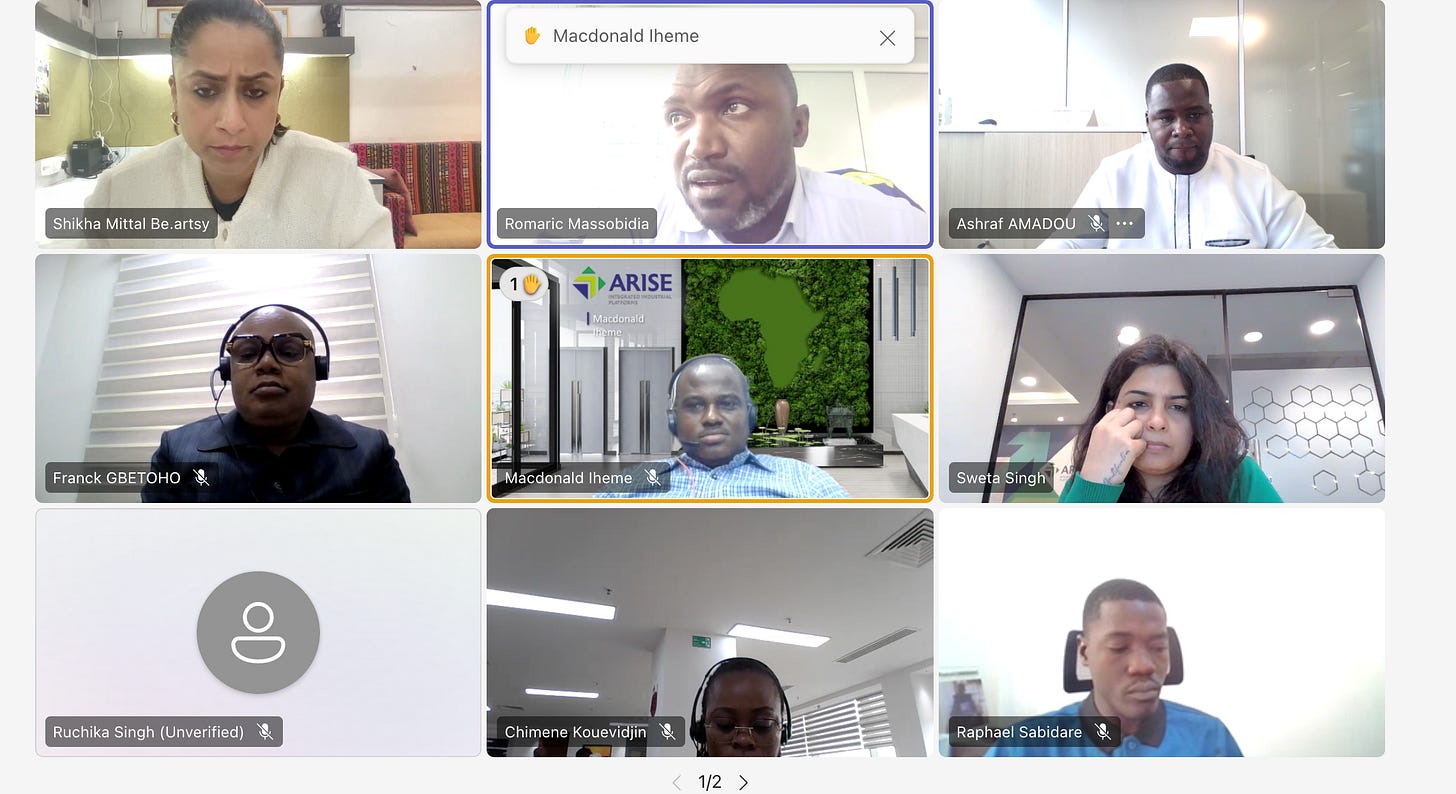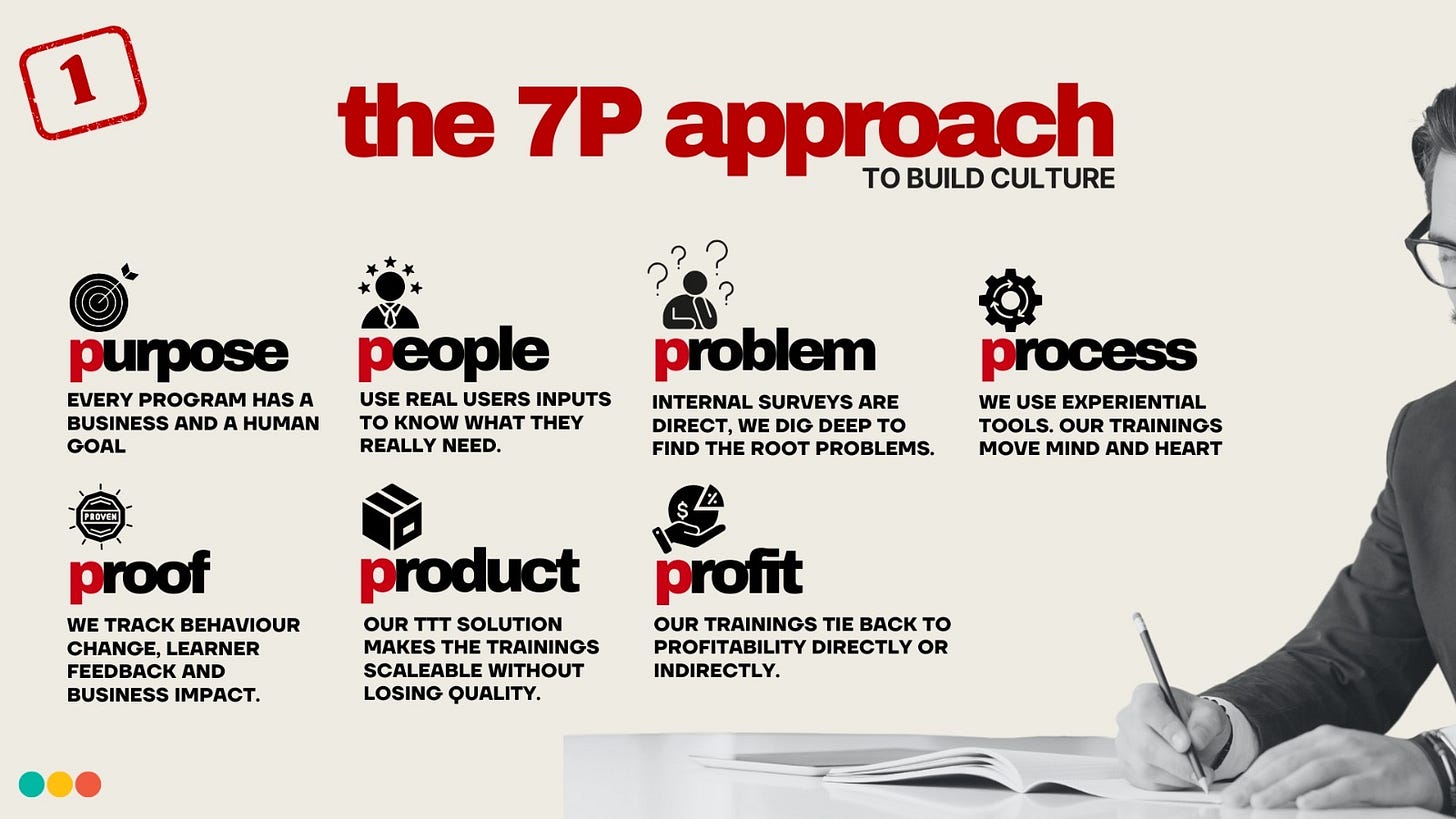Avoiding Wrong Turns in Training
Edition 27: 7P Approach on Designing the Most Effective Learning and Development Programs
Edition #027: Avoiding Wrong Turns in Training - The Be.artsy 7P Approach
My mission with this newsletter is simple but ambitious: to help 100,000 professionals shift from being People Pleasers to becoming Culture Builders.
In the last edition, we uncovered the hidden flaw in workplace learning: how bias, when left unaddressed, quietly shapes the way we train, lead, and grow. This time, we move from diagnosis to design.
Because here’s the truth:
Most training doesn’t fail because it’s boring- it fails because it’s misaligned.
It solves the wrong problem. Targets the wrong audience. Prioritises performance over purpose. Or, worse, becomes a ritual of box-ticking without meaningful change.
At Be.artsy, we’ve spent years asking:
What makes training stick?
What makes learning feel human, impactful, and scalable?
How do we ensure culture and capability grow together, not apart?
The answer lies in a structured yet flexible model we call the 7P Approach.
In this edition, I’ll walk you through how we use this method to build programs that don’t just sound good in theory but actually deliver on the ground. Whether you're designing for compliance, sales, inclusion, or leadership, this is the map to avoid wrong turns.
Let’s get into it.
In the world of Learning & Development, the biggest challenge isn’t just designing a training program it’s designing the right one. Too often, organisations pour time, money, and energy into training initiatives that miss the mark. Employees leave sessions uninspired. Managers see no behavioural change. And business impact? Nearly invisible. Why does this happen?
Because somewhere along the way, training takes a wrong turn but it’s usually avoidable.
That’s where Be.artsy’s 7P Approach comes in.
It’s a powerful lens we use to design purposeful, performance-driven training programs that don't just feel good; they actually work.
Here’s how it works:
1. Purpose: Start With the ‘Why’
Before designing a module or choosing a format, ask: Why are we doing this training at all?
Is it for compliance? Behaviour change? Skill building? Culture shift?
Without a clearly defined purpose, training becomes an activity, not a transformation. A wrong turn starts here when “more training” is seen as the solution, instead of solving for why people need to learn.
Be.artsy Tip: Every program must have a business and a human goal.
We Avoid: Generic Context.
Example: POSH (Prevention of Sexual Harassment) Training
Most POSH compliance training follows a checklist:
Define sexual harassment
Introduce the Vishaka Guidelines and POSH Act
Clarify the role of the Internal Committee
Explain timelines and procedures
Ensure attendance and acknowledgement
That’s compliant POSH. But impactful POSH training does more:
Contextualises harassment within real workplace power dynamics
Builds empathy and emotional awareness
Challenges gender norms
Reinforces the link between safety and performance
Be careful when you deliver POSH only for compliance. That’s paperwork not prevention. Done right, POSH training can:
Create a Culture of Psychological Safety
Strengthen Employer Brand and Trust
Reinforce Leadership Accountability
Example: Air India partnered with Be.artsy when facing repeated internal complaints. Our customised training turned compliance into culture-building. [Click below to read more.]
2. People: Know Who You’re Training
One size fits no one. Who are your learners?
First-time managers? Frontline sales staff? Engineers?
What is their motivation? What is their fears? What biases might they carry?
Training often goes off-track when it speaks at people, not to them. Empathy is the GPS here. The wrong turn? Designing training for “everyone” with generic content.
Be.artsy Tip: Involve real learners before finalising your design. Ask what they truly need.
We Avoid: Mismatch between content and audience expectations.
Example: In our “GrowHer” program for aspiring women leaders, we first ask participants to identify which leadership quadrants they naturally relate to -Doer, Creator, Profit or Power. A successful leader will tap into all four. This exercise builds awareness of what to develop next.
3. Problem: Name It Clearly
No training should begin without naming the real problem.
Example:
“Low productivity” may not be about skill; it could be morale.
“Gender inclusion issues” may be rooted in unconscious bias, not awareness.
If you don’t solve the real problem, you’ll be solving the wrong one and no training will fix that.
Be.artsy Tip: Spend more time diagnosing than designing. Use internal surveys, conduct pre-program interviews, and ask tough questions.
We Avoid: Surface-level interventions.
Example: A client once requested conflict management training. On deeper analysis, we uncovered that the core issue wasn’t conflict it was a breakdown of trust in leadership. The solution? A redesign focused on open communication, feedback, and rebuilding psychological safety.
4. Process: Map the Experience
Training isn’t just a workshop; it’s an experience.
Your process must answer:
How will you engage learners before, during, and after the session?
What mix of methods will you use: role plays, theatre, simulations, stories, feedback loops?
A wrong turn here leads to dull PowerPoint marathons that no one remembers.
Be.artsy Tip: Use experiential tools that engage both the mind and the heart.
We Avoid: Boring programs with no business impact.
Example: Ethics is not an easy topic. A traditional classroom approach can feel dry and distant. When we used street theatre for Tata Bluescope, participants said it brought real ethical dilemmas to life and stayed with them long after the session.
5. Proof: Show What Changed
If you can't measure it, you can't improve it.
What changed after the training?
Are people using what they learned?
Did KPIs shift?
Is feedback better?
Did something actually improve?
Many programs end with applause, but no evidence. That’s a wrong turn we must not normalise.
Be.artsy Tip: Measure behaviour change, learner feedback, and business metrics.
We Avoid: Feel-good sessions that don’t move the needle.
Example: Many organisations skip post-program measurement. But those who do it well like Asian Paints, can link training to increased employee retention, faster role transitions, and improved productivity.
6. Product: Make It Scalable
Your training isn’t an event- it’s a product.
It should be replicable across geographies, teams, and time.
Ask:
Can this be delivered again, consistently, without losing quality?
Are there toolkits, facilitator guides, feedback forms?
Be.artsy Tip: Think like a product manager. Build assets, refine versions, and set up a feedback loop.
We Avoid: One-off programs that can’t scale.
Example: Our Train-the-Trainer program at ICICI Lombard scaled to over 10,000 employees. The same model also worked in Africa across ARISE IIP in Benin, Togo, and Gabon with contextual customisation.
7. Profit: Link to Business Metrics
This is the big one.
What’s the ROI of your training?
Can you show:
Reduced attrition
Increased sales
Improved onboarding
Faster promotions
Better team collaboration
If training doesn’t tie back to business results, it becomes a cost, not an investment.
Be.artsy Tip: Design with KPIs in mind from Day 1.
We Avoid: Vanity metrics and vague outcomes.
Example: One of our clients linked their manager effectiveness scores to Be.artsy’s customised inclusion program and saw a 17% improvement in team satisfaction within six months.
Best | Shikha Mittal | Founder, Be.artsy
Forward this newsletter to a friend or colleague. Once they register, they’ll start receiving the newsletter too.Why Subscribe?
Why Subscribe?
People Please is a thoughtfully crafted newsletter for professionals seeking a fresh, honest perspective on learning and development, both personal and professional.
Over the past 15 years, I’ve collaborated with 450+ organisations across 48 industries, designing and delivering culture & learning and developing programs impacting over 500,000 professionals through my enterprise, Be.artsy. which I founded in 2010 in Delhi, India.
Be.artsy’s work has been widely featured in national and international media outlets including Forbes India, BBC, DW Media.
For culture building, learning and development programs and other business inquiries, please reach out to Be.artsy’s Growth Manager.






